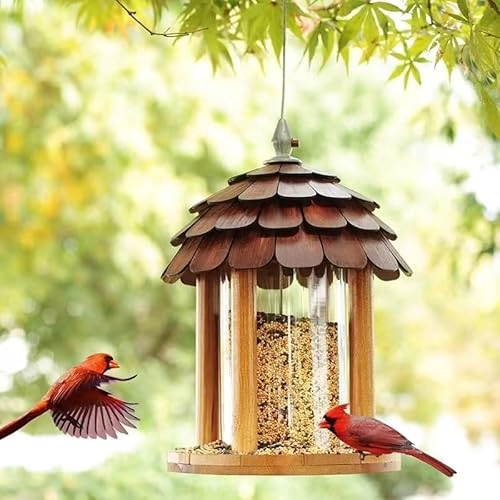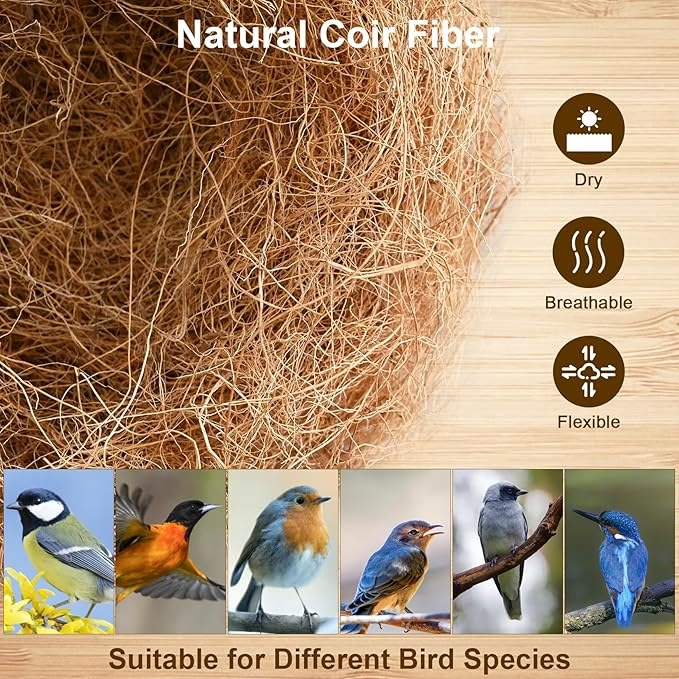Cardinal Bird Feeders attract beautiful red cardinals to your backyard. They provide food and a safe spot for these lovely birds.
In this blog post, we will explore the appeal of cardinal bird feeders and why they are essential for bird lovers. Cardinals are a joy to watch with their bright red feathers and cheerful songs. A well-placed bird feeder can turn your backyard into a bird-watching paradise.
Cardinals prefer feeders that offer easy access and a steady food supply. Choosing the right feeder means more visits from these stunning birds. Whether you are a seasoned bird watcher or new to the hobby, understanding what cardinals need will enhance your experience. Get ready to enjoy the beauty and charm of cardinals right in your own yard. Click here to purchase the Cardinal Bird Feeder.
Introduction To Cardinal Bird Feeders
Cardinal bird feeders attract beautiful red cardinals to your garden. These feeders provide seeds and a safe feeding spot. Enjoy watching these vibrant birds up close.
Cardinal bird feeders are perfect for attracting vibrant red cardinals. They provide a dedicated feeding space for these beautiful birds. Cardinals often struggle to find food during winter. These feeders help them survive harsh conditions. They also bring joy to bird lovers.
Purpose And Benefits
Cardinal bird feeders serve multiple purposes. They attract cardinals to your garden. This gives you a chance to observe their beauty. They also ensure cardinals have enough food. This is especially important during colder months. These feeders can enrich your backyard ecosystem. Cardinals help control pests. They also add a splash of color to your garden. Watching cardinals can be a stress-relieving activity. It’s a win-win situation for both birds and humans.
Popular Types
There are several types of cardinal bird feeders. Hopper feeders are a popular choice. They store more seeds and protect them from rain. Tube feeders are another option. They have multiple perches for cardinals to sit on. Platform feeders are also common. They offer a large, flat feeding area. Some feeders are designed to be squirrel-proof. This ensures only birds get the food. Choosing the right feeder depends on your needs and preferences. “`
Choosing The Right Location
Choosing the right location for your cardinal bird feeder is crucial. It ensures that these beautiful birds feel safe and welcome. The right spot can attract more cardinals and provide you with a delightful bird-watching experience.
Ideal Placement
Place the feeder at least 5 feet above the ground. This height deters predators and gives cardinals a sense of security. Ensure the feeder is in a quiet area. Cardinals prefer peaceful surroundings. Position the feeder near trees or shrubs. This provides cover and a quick escape route.
Safety Considerations
Keep the feeder away from windows to prevent collisions. Place it at least 10 feet from your house. Ensure there’s no easy access for squirrels. Use baffles or other deterrents. Regularly check the feeder’s condition. Ensure it’s clean and free from mold.
Types Of Feeders
Choosing the right bird feeder can attract more cardinals to your yard. Different feeders suit different types of birds. Let’s explore some popular feeder types for cardinals.
Hopper Feeders
Hopper feeders are a favorite for cardinals. They have a roof and walls to protect the seeds. These feeders usually hold a large amount of seed. The seeds stay dry, which is important for birds. Cardinals find it easy to perch and feed on these feeders.
Platform Feeders
Platform feeders are simple and versatile. They are flat and open with no walls or roof. Cardinals can land and feed from any direction. These feeders can hold a variety of foods, including seeds and fruits. They are easy to clean and refill.
Cardinal-friendly Foods
Providing the right food for cardinals can attract them to your feeder. Cardinals have specific preferences that ensure they thrive and stay healthy. Understanding their favorite foods can make your bird feeder a cardinal hotspot.
Seed Preferences
Cardinals love sunflower seeds. Black oil sunflower seeds are their top choice. These seeds have thin shells, making them easy to crack. Cardinals also enjoy safflower seeds. These seeds are bitter but preferred by cardinals and not by squirrels.
Supplemental Foods
Cardinals appreciate more than just seeds. They like fruits such as berries and grapes. Fresh or dried, these fruits are a tasty treat. Cardinals also eat insects. Mealworms are a good option to provide. They offer protein which is vital for cardinals, especially during breeding season.
Maintaining Your Feeder
Keeping your cardinal bird feeder in top condition is crucial. This ensures the birds have a safe and healthy place to eat. Regular maintenance can prevent issues like mold and grime build-up. Below, you’ll find useful tips on how to maintain your feeder effectively.
Cleaning Tips
Regular cleaning of your cardinal bird feeder is essential. It keeps the feeder inviting for birds and reduces the risk of disease.
- Disassemble the feeder: Take apart all removable parts.
- Soak in soapy water: Use warm, soapy water to soak the parts for 10 minutes.
- Scrub thoroughly: Use a brush to scrub all surfaces, especially the corners.
- Rinse well: Make sure to rinse all soap off the feeder parts.
- Dry completely: Let all parts air dry before reassembling.
Try to clean your feeder at least once every two weeks. If the weather is humid or rainy, clean it more often.
Preventing Mold
Mold in your bird feeder can be harmful to birds. Follow these steps to prevent mold:
- Use fresh seeds: Always fill the feeder with fresh, dry seeds.
- Check daily: Inspect the feeder daily for signs of mold or dampness.
- Drain holes: Ensure your feeder has proper drainage holes to keep seeds dry.
- Keep it shaded: Place the feeder in a shaded area to reduce moisture.
- Clean spills: Wipe away any spilled seeds around the feeder.
By keeping your feeder clean and dry, you create a healthy environment for cardinals and other birds. Click here to learn how to maintain bird feeders.
Seasonal Considerations
Cardinal bird feeders offer more than just a food source for these beautiful birds. The changing seasons affect how you should approach feeding cardinals. Adapting your feeding strategies ensures that these vibrant birds remain healthy and happy all year round.
Winter Feeding
Winter can be harsh for cardinals. Food sources become scarce. Offering high-energy foods helps them survive. Suet, sunflower seeds, and peanuts are excellent choices. These foods provide the necessary fat and protein. Place the feeder in a sheltered spot. This helps protect the birds from strong winds. Regularly check and refill the feeder. This consistency helps cardinals depend on your feeder.
Summer Feeding
Summer provides abundant natural food sources for cardinals. But they still appreciate a well-stocked feeder. Offer a variety of seeds, fruits, and insects. This variety attracts more cardinals. Ensure the feeder is clean. Bacteria and mold grow faster in summer heat. Regularly clean the feeder with mild soap and water. Provide fresh water nearby. A birdbath attracts cardinals and other birds. Hydration is vital during hot summer days.
Attracting Cardinals
Cardinals are vibrant, beautiful birds that many bird lovers adore. To attract these stunning birds to your garden, a well-placed bird feeder is essential. But there are other ways to make your yard more appealing to cardinals. Adding water features and planting specific plants can create an inviting environment for these birds.
Using Water Features
Water features attract cardinals effectively. Birds love fresh, clean water for drinking and bathing. Adding a birdbath or a small fountain helps. Ensure the water is shallow, as cardinals prefer shallow water. Clean the water feature regularly to prevent algae and mosquitoes. Moving water, like a dripper or mister, can be especially attractive to cardinals.
Planting Cardinal-friendly Plants
Specific plants attract cardinals by providing food and shelter. Planting native trees and shrubs is an excellent strategy. Cardinals enjoy seeds from sunflowers, dogwoods, and serviceberries. Berry-producing plants like holly, elderberry, and blackberry are also favorites. Dense shrubs and evergreens give cardinals a place to nest and hide from predators. A mix of plants ensures food and shelter year-round, keeping cardinals in your garden.
Common Problems And Solutions
Feeding cardinals can be a delightful experience. But it comes with challenges. This section addresses common problems and provides solutions to enhance your bird feeding experience.
Squirrel Deterrents
Squirrels love bird feeders. They can consume all the birdseed quickly. This leaves little for the cardinals. Here are some effective squirrel deterrents:
- Baffle Installation: Install a baffle above or below the feeder. This prevents squirrels from accessing the seed.
- Squirrel-Proof Feeders: Use feeders designed to keep squirrels out. These feeders have weight-sensitive perches that close off access when a squirrel lands.
- Location: Place feeders away from trees or structures. Squirrels can jump long distances.
- Spicy Seed: Mix cayenne pepper with birdseed. Birds are not affected, but squirrels dislike it.
Preventing Feeder Domination
Aggressive birds can dominate feeders, preventing cardinals from feeding. Here are some tips to manage this problem:
- Multiple Feeders: Set up several feeders. This reduces competition and allows cardinals to feed peacefully.
- Feeder Types: Use feeders that cater to cardinals. Tube feeders with smaller perches can deter larger, aggressive birds.
- Feeder Placement: Position feeders at different heights. Cardinals prefer feeders placed at mid-level heights.
- Feeding Schedules: Fill feeders at different times of the day. This can help balance feeding opportunities for all birds.
By addressing these issues, you can create a more welcoming environment for cardinals. Enjoy watching these beautiful birds thrive in your backyard.
Enjoying Your Cardinal Visitors
Attract vibrant cardinals to your garden with a specialized bird feeder. These feeders provide the perfect spot for these beautiful birds to visit. Enjoy watching them as they feed and bring color to your outdoor space.
Welcoming cardinals to your yard can be a delightful experience. Their bright red feathers and cheerful songs can brighten any day. Setting up a cardinal bird feeder is just the first step. Knowing how to enjoy their presence makes it even more special.
Birdwatching Tips
Place your bird feeder in a quiet spot. This helps cardinals feel safe. Ensure the feeder is visible from your favorite window. Early mornings and late afternoons are prime times for birdwatching. Keep a pair of binoculars handy. This allows you to see details without disturbing the birds. Stay still and quiet. Cardinals may be cautious at first.
Photography Suggestions
Position your camera near the feeder. Use a tripod for clear shots. Natural light works best. Morning light is soft and flattering. Avoid using flash. It can scare the birds away. Set your camera to a fast shutter speed. This helps capture their quick movements. Be patient. Good photos often take time. Try different angles. This adds variety to your photos. “`
Credit: www.pinebarrens.org
Frequently Asked Questions
A tube feeder with large perches or a hopper feeder is ideal for cardinals. They prefer feeders with sturdy perches.
Use sunflower seeds, safflower seeds, and peanuts to attract cardinals. Place the feeder in a quiet, sheltered spot.
Place the feeder in a quiet, protected area with nearby trees or shrubs. Cardinals prefer low-lying feeders.
Clean your feeder at least once a week. This prevents mold and bacteria, keeping the birds healthy.
Conclusion
Cardinal bird feeders bring joy to your garden. They attract beautiful cardinals quickly. Easy to set up and maintain. Cardinals love them, and so will you. Watch these red beauties from your window. Enhance your outdoor space effortlessly. Enjoy nature’s charm at home.
Happy bird watching!




1 thought on “Cardinal Bird Feeder: Attract Stunning Red Cardinals Today”